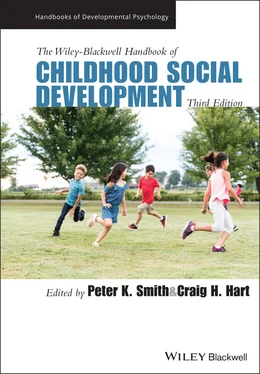Earlier molecular genetic studies of social development used the candidate gene approach. These studies focused on one or a few SNPs (or other types of polymorphisms) in a specific gene of a biological pathway that is known to be implicated in a specific trait. Each SNP has 2 variants (alleles). If one allele (e.g., one form of a particular SNP) increases a chance of development of a particular trait, then we can identify the association of this allele with a specific trait by using simple statistical methods, such as linear regression analysis for a continuous trait, or logistic regression analysis for a binary trait. For example, in a genetic association study of antisocial behavior by using a case‐control design, the frequency of an allele associated with antisocial behavior will differ statistically between cases and controls.
Using the candidate‐gene approach, a number of genes, mainly involved in neurotransmitter pathways (serotonin, dopamine, and norepinephrine), have been studied for associations with antisocial behavior and/or aggression. There is some evidence for the role of the following genes in youth and/or adult antisocial behavior: Catechol‐O‐methyl‐transferase (COMT) (Qayyum et al., 2015), Monoamine oxidase A (MAOA), (Manuck et al., 2000), Serotonin transporter (SLC6A4), (Bellivier et al., 2000) and tryptophan hydroxylase (TPH), (Manuck et al., 1999). Fewer studies have been conducted in children. In one such example, an association was demonstrated between a polymorphism of the dopamine D4 receptor gene (DRD4) and maternal report of child aggression at age four (Schmidt et al., 2002). Evidence of associations of child aggression with common polymorphisms of SLC6A4 (Beitchman et al., 2003) and COMT (Caspi et al., 2008) have also been reported, although results are inconsistent (Schmidt et al., 2002).
However, a systematic meta‐analysis of 185 studies of 31 candidate genes showed the absence of reliable associations between analyzed genetic variants and aggression (Vassos et al., 2014). Subgroup analysis, which took into account the severity of disorder, and sample characteristics, did not find any significant associations. There are a number of problems related to these reports of candidate gene associations, such as generally very low statistical power and difficulties with reproducibility (replication) of the initial findings.
One of the latest developments in molecular genetic research is the Genome‐Wide Association Study (GWAS) approach, in which hundreds of thousands of SNPs are tested simultaneously for associations with a particular trait (Hirschhorn & Daly, 2005). Application of this method in large samples (tens or even hundreds of thousands of participants) allows for identification of multiple DNA markers of small effect. At the time of writing (January 2021), there have been 227,631 significant associations identified between common genetic variants (polymorphisms) and various traits. This list is continuously updated by the NHGRI‐EBI Catalog of human genome‐wide association studies (Available at http://www.genome.gov/gwastudies/).
To date, there have been three GWAS studies of adult antisocial behavior. Salvatore, Aliev, and colleagues (2015) conducted a case‐control study using a sample of 1,379 participants in which the cases met criteria for alcohol dependence. The results indicated that more significantly associated genes were over‐represented in seven gene sets, and most were immune related. The most highly associated SNP was located in the ABCB1 gene, which is robustly expressed in the brain. Another study of a broad spectrum of antisocial behavior by Tielbeek and colleagues (2017) is the largest study of this phenotype conducted up to date, with combined data from five large population‐based cohorts and three target samples. The discovery samples comprised 16,400 individuals, whereas the target samples consisted of 9,381 individuals (all individuals were of European descent), including child and adult samples (mean age range, 6.7–56.1 years). Three promising loci with sex‐discordant associations were found: two in females, (chromosome 1: rs2764450, chromosome 11: rs11215217) and one in males (chromosome X, rs41456347) (Tielbeek et al., 2017). Finally, a study using a family‐based GWAS approach in participants from the Collaborative Study on the Genetics of Alcoholism (European ancestry = 7568; African ancestry = 3274) did not discover any robust genome‐wide significant signals for any of the externalizing scores derived from criterion counts of five DSM disorders (alcohol dependence, alcohol abuse, illicit drug dependence, illicit drug abuse, and either antisocial personality disorder or conduct disorder) (Barr et al., 2020).
Overall, very few associations of genetic variants with antisocial behavior have been found so far and they need replication in independent studies. Similar to candidate gene association studies, possible reasons for the lack of robust findings in GWAS include: a low statistical power associated with small sample sizes; phenotypic heterogeneity; and sample differences (age, ethnicity) (Manolio et al., 2009). In addition, technical characteristics of genotyping methods may also contribute to nonreplication. Most GWASs have focused on common, rather than rare, genetic variants, such as common SNPs. However, rare deletions and insertions in the genome can play an important role. For example, effects of rare copy number variants (CNVs) have been shown in studies of autism spectrum disorder (Levy et al., 2011) and ADHD (Elia et al., 2012; Hawi et al., 2015). More recently, high‐throughput sequencing methods have been employed to study rare point mutations across the whole genome (Iossifov et al., 2014; Yuen et al., 2015). It is increasingly evident that the genetic architecture of psychological traits involves both common and rare variants and their impact on hundreds of genes. Establishing the sequence of all three billion nucleotide base pairs of an individual is becoming progressively cheaper (the cost of sequencing a genome is approximately $1,000; www.genome.gov/sequencingcosts). In the near future, it will be possible to sequence the whole genome of all people. This development may lead to unprecedented opportunities for scientific discoveries and for applying these discoveries for the benefit of all people.
Although most SNPs have very small effects on phenotypes, tens and hundreds of individual SNPs can be aggregated into SNP composites. Such a composite is called a polygenic (risk) score (PS or PRS), or polygenic index. Polygenic scores can be used to determine a degree of genetic probability for developing a particular trait or a disorder. For example, (Salvatore, Aliev et al., 2015) reported that polygenic scores for externalizing disorders – based on SNP weights derived from GWAS results in 1,249 adults – predicted externalizing disorders, subclinical externalizing behavior, and impulsivity‐related traits among 248 adolescents and 207 young adults.
Polygenic scores can also be used for identifying genetic overlaps between different traits or disorders. Tielbeek and colleagues (2017) detected a significant inverse genetic correlation of polygenic scores for antisocial behavior with educational attainment (r = ‐0.52), suggesting common genetic mechanisms between these two phenotypes. Interestingly, a different study tested how polygenic scores showing low educational attainment were related to the development of antisocial behavior from childhood through adulthood using data from two population‐based birth cohort studies, the Dunedin birth cohort from New Zealand and the E‐Risk study from the United Kingdom (Wertz et al., 2018). They found that the education‐related polygenic score predicted risk of a criminal record with modest effect sizes. Moreover, polygenic risk manifested during primary schooling in lower cognitive abilities, lower self‐control, academic difficulties, and truancy, and it was associated with a life‐course‐persistent pattern of antisocial behavior that has an onset in childhood and persists into adulthood.
Читать дальше












